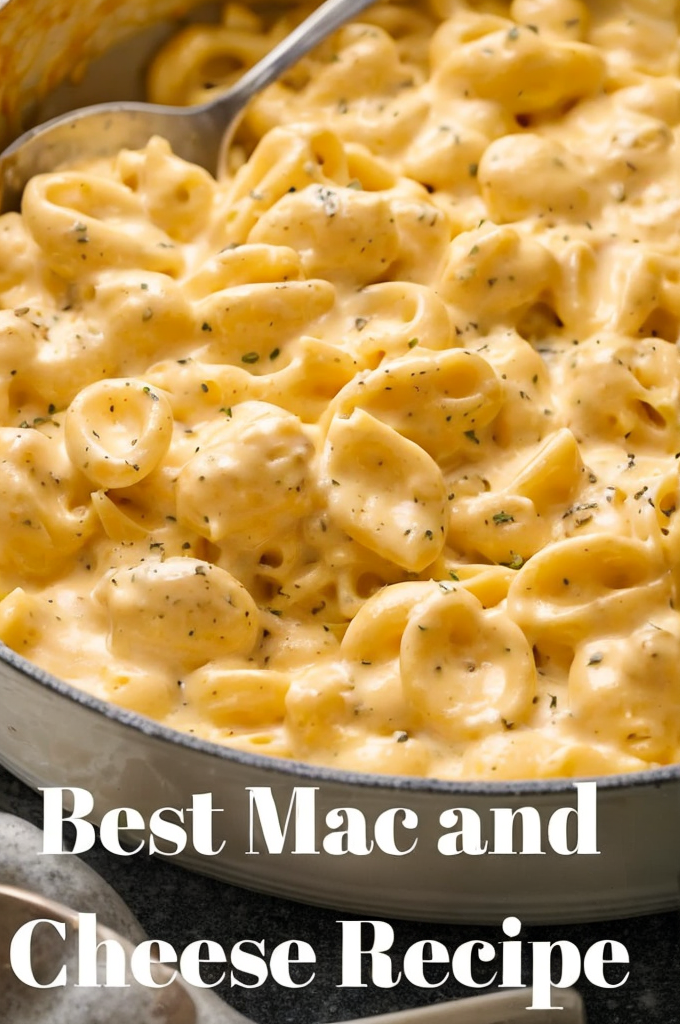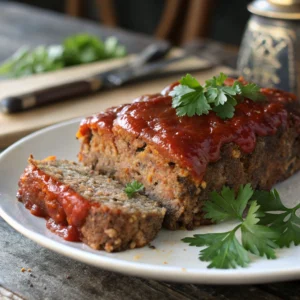Ultimate Extra Creamy Mac and Cheese: The Perfect Comfort Dish in 30 Minutes
Mac and cheese is the epitome of comfort food, and our Ultimate Extra Creamy Mac and Cheese recipe takes this classic dish to a whole new level. Imagine tender morsels of pasta drenched in a rich, velvety cheese sauce that melts in your mouth. In just 30 minutes, you can whip up this heavenly delight, perfect for a quick weeknight meal or an indulgent dinner party dish. With its deeply satisfying flavor and silky texture, this mac and cheese is sure to please even the most discerning palates.
Quick Recipe Highlights
- Flavor Profile: Creamy, cheesy, with a hint of nuttiness from the cheese blend.
- Texture: Soft pasta enveloped in a rich and smooth cheese sauce.
- Aroma: Inviting and cheesy with a slight hint of spices like nutmeg.
- Visual Appeal: Golden and bubbling with a lightly browned top.
- Skill Level Needed: Easy for beginner cooks; involves basic pasta boiling and sauce making.
- Special Equipment: A good whisk for sauce making enhances the final texture.
Recipe Overview
- Difficulty Level: This recipe is approachable for cooks of any level. The steps are straightforward and focus mainly on sauce preparation and pasta cooking.
- Category: Side dish or main course, ideal for comfort food lovers and family meals.
- Cuisine: This recipe is inspired by both traditional American mac and cheese and a hint of French béchamel sauce techniques.
- Cost: Economical, utilizing affordable pantry staples like pasta, cheese, and milk, adding up to a reasonable meal or side dish cost.
- Season: Enjoy all year round, though it pairs wonderfully with cooler, cozy months for its warming qualities.
- Occasion: Suitable for weeknight dinners, potlucks, family gatherings, or festive celebrations.
Why You’ll Love This Recipe
The taste of this creamy mac and cheese is unparalleled, with a depth of flavor that comes from the blend of cheeses and a pinch of seasoning. The texture is exceptionally smooth, wrapped around perfectly cooked pasta, making each bite a luxurious experience. This meal is incredibly convenient, requiring minimal preparation time while providing maximum flavor. It’s a comfort dish that makes any weekday meal feel special and satisfying.
The nutritional benefits of this dish can be optimized by using whole-grain pasta or adding vegetables. The dish becomes a balanced meal packed with protein and fiber when paired with a salad or steamed greens. Socially, this dish is a crowd-pleaser, perfect for potlucks or larger gatherings. It’s guaranteed to prompt requests for seconds and recipe shares.
In terms of cost, mac and cheese is an accessible dish, with ingredients that are either already at home or easy to acquire without breaking the budget. When scaled up, too, it remains a cost-effective option that serves a crowd.
Historical Background and Cultural Significance
Mac and cheese has a rich history dating back to the 18th century and quickly became a beloved American dish with Thomas Jefferson’s rumored influence. Its evolution has seen countless variations, from basic stove-top versions to gourmet iterations featuring lobster or truffles. Culturally, it represents comfort and nostalgia, a dish that evokes memories of home-cooked meals and family gatherings.
The roots of this creamy delight lie in both European culinary traditions, with bechamel sauce’s French origins potentially sparking the idea of a creamy sauce base for pasta. Regional versions vary, with the Southern United States famous for its baked macaroni iterations featuring a crispy top.
Ingredient Deep Dive
Cheese is the pivotal ingredient in mac and cheese, providing both flavor and texture. Traditional choices include cheddar, which offers a sharp, tangy, and robust flavor profile. Selecting quality cheese elevates the dish’s taste profile and nutritional value, offering calcium and protein.
Milk acts as the base of the creamy sauce, creating a smooth consistency crucial for coating the pasta evenly. Whole milk is often preferred for its richness, but lower-fat options or plant-based milk can also be used for lighter or vegan versions.
Common Mistakes to Avoid
- Not salting the pasta water can result in bland mac and cheese. Always season the water generously like seawater.
- Overcooking the pasta leads to a mushy final dish. Cook until just al dente, as it will continue cooking in the sauce.
- Using pre-shredded cheese, which often contains anti-caking agents that prevent smooth melting.
- Neglecting to whisk the sauce constantly can leave you with lumps. Ensure continuous stirring for a velvety finish.
- Adding cheese over high heat can cause it to become grainy. Gradually melt the cheese on low heat.
- Skipping baking with breadcrumbs, which adds a delightful textural contrast missing from a stovetop version.
- Forgetting to taste and adjust seasoning before serving is a common error. Always taste for salt and spice balance.
- Omitting the roux stage. This step is key for thickening the sauce properly.
Essential Techniques
Making a roux is a foundational technique in creating the creamy sauce, essential for thickening. Mastery involves equal parts butter and flour cooked until they form a paste without color. Proper visual cues include a smooth, sandy texture before milk incorporation.
Gradual cheese melting ensures that your sauce remains creamy and smooth. Adding cheese too quickly or at high temperatures risks a grainy consistency. For best results, add cheese in small batches, stirring constantly until fully melted and incorporated.
Pro Tips for Perfect Ultimate Extra Creamy Mac and Cheese
Use a blend of cheeses, such as sharp cheddar and gouda, for depth of flavor and creaminess. A bit of cream cheese can enhance the sauce’s richness.
Cook pasta to al dente, as it will absorb some sauce moisture and soften further during mixing. For added flavor, incorporate spices like mustard powder or smoked paprika for a touch of complexity.
Reserve some pasta water to adjust the sauce consistency at the end. This starchy water helps in smoothing out the sauce as needed.
For a crunchy top, sprinkle bread crumbs mixed with a little melted butter over the mac before baking. This creates a pleasant contrast to the creaminess below.
To prevent a greasy finish, ensure the sauce ingredients, particularly cheese, are well emulsified. Add cheese off the heat and stir until fully melted.
Variations and Adaptations
Regional variations such as Southern-style baked mac and cheese feature a custard-like consistency with eggs mixed into the sauce. Seasonal adaptations can include incorporating spring vegetables like peas or asparagus for freshness. Dietary modifications allow for gluten-free pasta or a plant-based cheese sauce for those with dietary constraints.
Flavor variations include mixing in spicy elements like jalapeños or incorporating savory meat like bacon or pancetta. Presentation alternatives might involve serving in individual ramekins for a more refined look.
Serving and Presentation Guide
Mac and cheese can be plated as a main entrée with a side salad or served as a side dish in family-style meals. For garnishing, consider fresh herbs like chives or parsley for a pop of color. Traditional accompaniments include a light, tangy salad to balance the richness or roasted vegetables.
Serving suggestions may feature a warm cast iron dish at the table, retaining heat for longer. Portion control is crucial as this dish can be quite filling; aim for a serving that satisfies but allows for room to enjoy accompaniments.
Wine and Beverage Pairing
Pairing wines like Chardonnay or Sauvignon Blanc complements the creamy and rich flavor profile of mac and cheese. Non-alcoholic alternatives such as a crisp sparkling water with a splash of lemon can refresh the palate.
If coffee or tea is your preference, a light-bodied black tea or weak coffee can work to cleanse between bites. Serve beverages at a cool temperature to contrast refreshing elements.
Storage and Shelf Life
Store leftover mac and cheese in airtight containers in the refrigerator for up to three days. Use tools like sturdy Tupperware or Pyrex glass containers to maintain quality. Signs of spoilage include sour odor or discoloration. Reheat portions in a microwave or, for better consistency, in an oven to revive the creamy texture, with a splash of milk added during reheating.
Make Ahead Strategies
Prepare components like pasta and cheese sauce separately, storing the sauce in the refrigerator for up to two days in advance. Quality might decrease slightly, but assembly and quick baking can restore the original flavor. Reheat the sauce gently on the stove before combining with freshly cooked pasta.
For storage between steps, ensure the pasta is well-drained and tossed with a bit of oil to prevent sticking. Quality assessment involves confirming the sauce has retained its creamy consistency.
Scaling Instructions
When halving the recipe, adjust ingredients proportionally to maintain taste balance. Doubling requires larger equipment, such as bigger pots and baking dishes. Cooking time may decrease or increase slightly, requiring attention to cues like sauce thickness and overall consistency.
For storage, ensure excess portions are divided into meal-sized amounts to prevent waste and ensure easy reheating.
Nutritional Deep Dive
The macronutrient breakdown includes carbohydrates primarily from the pasta, proteins from cheese and milk, and fats from the sauce, particularly if using full-fat cheese. Micronutrients include calcium and vitamin D from dairy sources.
Health benefits can be optimized by using whole-grain pasta or adding vegetables for fiber. Portion analysis should consider roughly one cup per serving for balanced plate inclusion. For weight management, consider modifications like using reduced-fat cheese.
Dietary Adaptations
For gluten-free adaptations, use gluten-free pasta and flour alternatives like rice flour for the roux. Dairy-free versions might involve nut-based cheese or plant milk-based sauces. The vegan variation can include nutritional yeast for a cheesy flavor.
Low-carb modifications could involve using cauliflower as a pasta alternative for a vegetable-focused dish.
The Recipe
Ultimate Extra Creamy Mac and Cheese
Serves: 4
Prep Time: 10 mins
Cook Time: 20 mins
Total Time: 30 mins
Kitchen Equipment Needed
- Pot for boiling pasta
- Saucepan for cheese sauce
- Whisk
- Oven-safe baking dish
Ingredients
- 8 oz elbow macaroni
- 2 cups shredded cheddar cheese
- 1 cup shredded gouda cheese
- 2 cups milk
- 2 tablespoons butter
- 2 tablespoons all-purpose flour
- Salt and pepper to taste
- 1 teaspoon mustard powder
- 1/4 teaspoon smoked paprika
Directions
- Bring a large pot of salted water to a boil, then add macaroni and cook until al dente. Drain and set aside.
- In a saucepan, melt butter over medium heat. Stir in flour, whisking briskly for about 1 minute.
- Gradually add milk, continuing to whisk to prevent lumps, until mixture thickens and bubbles.
- Reduce heat to low and add cheeses gradually, stirring until fully melted and sauce is smooth.
- Season with mustard powder, smoked paprika, salt, and pepper. Taste and adjust seasoning as needed.
- Add cooked pasta to the sauce, stirring to coat evenly.
- Transfer to an oven-safe dish. Bake at 350°F (175°C) for 15 minutes or until bubbly.
Recipe Notes
- For a breadcrumb topping, mix 1/2 cup breadcrumbs with 2 tablespoons melted butter and sprinkle over mac before baking.
- Feel free to switch cheese combinations based on preference, such as mozzarella or fontina.
Troubleshooting Guide
Texture issues: A lumpy sauce can be smoothed by whisking vigorously and adding a splash of milk to loosen if needed.
Flavor balance: If the dish is too bland, consider balancing with more salt, pepper, or cheese, enhanced by mustard powder or paprika.
Temperature problems: Ensure pasta is hot enough when stirring it into the sauce to meld flavors and consistency evenly.
Equipment challenges: If lacking an oven-safe dish, a stovetop method with covered simmering for 5-10 minutes can suffice.
Ingredient substitutions: For non-dairy alternatives, ensure plant-based products emulate similar textures; quality can vary widely.
Timing concerns: Pay attention to sauce thickening times; extend whisking if necessary to achieve preferred consistency.
Recipe Success Stories
Many readers have praised this recipe’s adaptable nature and ease, providing a perfect canvas for creativity. Success stories often feature variations like the addition of truffle oil or jalapeños for unique twists on the classic.
Families have lauded this dish for its kid-friendly nature and the nostalgic comfort it provides. Photos sent in by the community display golden-brown tops, showing the recipe’s excellent baking finish.
Frequently Asked Questions
Can I freeze mac and cheese?
Absolutely! After baking, allow it to cool, then store it in airtight containers or aluminum trays wrapped securely. Best consumed within a month for optimal flavor retention.
Which cheese works best for mac and cheese?
While cheddar is a classic, blending with cheeses like gouda or fontina will enhance creaminess. Combining cheeses with different textures and flavors brings depth and complexity.
How do I reheat without losing creaminess?
For best results, reheat in an oven at 350°F, adding a little milk or cream to keep the dish moist. Cover loosely to retain heat while encouraging even warming.
Can I make mac and cheese gluten-free?
Yes, substitute traditional pasta with gluten-free varieties and use gluten-free flour for the sauce. The cooking process and timings largely remain the same.
Is it possible to make this dish vegan?
Utilizing plant-based cheeses, margarine, and dairy-free milk, this dish can transform into a vegan delight. Nutritional yeast can be employed for additional “cheesy” flavor.
How do I prevent the cheese from becoming grainy?
Ensure cheese is gradually added over low heat, stirring constantly. Avoid high temperatures which can cause fats to separate from proteins.
What pasta shapes are best for mac and cheese?
Elbow macaroni is most common due to its ability to hold sauce well, but other shapes like cavatappi or shell pasta can offer pleasant variations.
Can I prepare mac and cheese in advance for a party?
Absolutely, you can pre-cook and store in the refrigerator. Reheat just prior to serving, ensuring to refresh with a bit of added cream to maintain moisture.
What sides complement mac and cheese?
Pair with lightly dressed greens or roasted veggies. A crisp salad with vinaigrette enhances balance, cutting through the richness of the cheese.
How can I add more protein?
Incorporate ingredients like cooked chicken or crispy bacon. Ground turkey can also seamlessly blend into the sauce for added texture and heartiness.
Additional Resources
For further culinary exploration, our pasta cooking guide delves deeper into mastering al dente perfection. Also, our cheese guide highlights selecting the right varieties for both flavor and nutrition.
Seasonal variations can be explored more with our autumn recipes, showcasing ingredients that align well with mac and cheese flavors, such as fresh squashes and earthy mushrooms.
Join the Conversation
We invite you to share your mac and cheese creations on social media using #UltimateCreamyMac. From innovative adaptations to classic recreations, your input enriches our recipe community.
Photography enthusiasts are encouraged to employ tips such as showcasing the cheesy texture with close-ups, enhancing the inviting golden hues, and capturing the bubbling bake top. We love reading your reviews, and your suggestions continually inspire new variations and inclusive adaptations.



